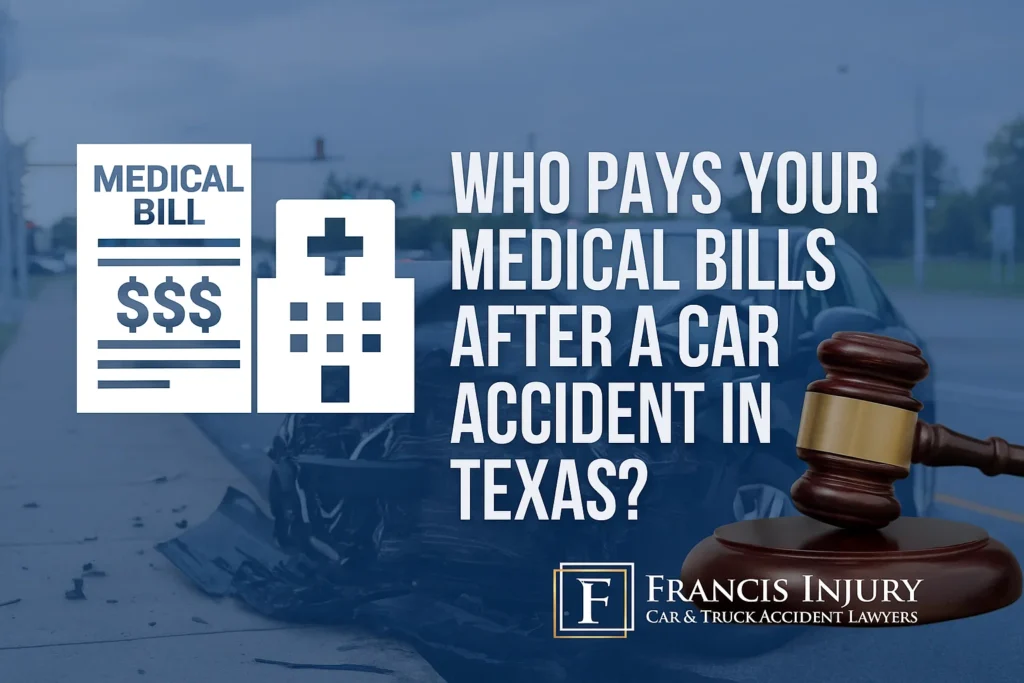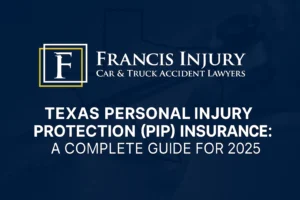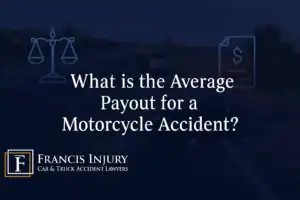
When you’re injured in a Texas car accident, one of the first and most stressful questions is: “Who will pay my medical bills?” From emergency room visits to follow-up surgeries and rehabilitation, expenses can add up fast. The confusion comes from Texas’ fault-based insurance system, combined with multiple layers of coverage like PIP, MedPay, health insurance, and the at-fault driver’s liability policy.
At Francis Injury, our Dallas–Fort Worth car accident lawyers help clients untangle this maze. Below, we break down how medical bills are paid after a crash in Texas—and how to protect yourself from being stuck with debt.
Texas Auto Insurance Basics: A Fault-Based System
Texas follows a fault-based insurance system, meaning the driver who caused the crash is financially responsible for damages—including medical bills. Every Texas driver must carry minimum liability coverage of $30,000 per person / $60,000 per accident for bodily injury, plus $25,000 for property damage (Texas Department of Insurance).
In practice, victims often face delayed payments because liability must be established before the at-fault driver’s insurer pays. That’s why your own coverages and health insurance become critical in the meantime.
Your Options for Paying Medical Bills After a Crash
1. Personal Injury Protection (PIP)
Texas law requires insurance companies to offer PIP coverage with every auto policy. Unless you rejected it in writing, you likely have it. PIP pays for:
- Medical expenses
- Lost wages
- Non-medical costs like childcare if accident-related
Standard PIP limits are $2,500–$5,000, but higher limits are available. It pays regardless of fault.
2. Medical Payments Coverage (MedPay)
MedPay is optional coverage that works like PIP but only reimburses medical bills (not lost wages). It often has lower premiums but narrower protection.
3. Health Insurance
Your health insurance may cover accident-related treatment—but beware: insurers often claim “subrogation rights,” meaning they expect reimbursement from your eventual settlement. An attorney can negotiate these liens down so you keep more of your recovery.
4. At-Fault Driver’s Liability Insurance
If another driver caused your crash, their liability policy should pay for your medical bills. However, these funds usually arrive only after settlement or judgment. In the meantime, hospitals may place liens against your settlement, giving them first claim to the payout.
5. Uninsured / Underinsured Motorist Coverage (UM/UIM)
Sadly, many Texas drivers carry no insurance or only the minimum. UM/UIM coverage on your own policy can step in when the at-fault driver cannot fully cover your losses.
When the Other Driver Is Uninsured or Underinsured (UM/UIM)
Texas requires drivers to carry minimum liability insurance ($30,000 per person / $60,000 per accident for bodily injury). Still, many drivers carry no insurance at all — and many others carry only the minimum. After a serious crash, those limits are quickly exhausted by emergency care, imaging, and follow-up treatment. That’s where Uninsured Motorist (UM) and Underinsured Motorist (UIM) coverage become crucial for protecting your health and your finances.
UM vs. UIM: What’s the Difference?
- Uninsured Motorist (UM): Applies when the at-fault driver has no liability insurance or in many hit-and-run incidents where the driver cannot be identified.
- Underinsured Motorist (UIM): Applies when the at-fault driver’s liability limits are not enough to cover your medical bills and other losses. Your UIM can bridge the gap up to your policy limits.
How UM/UIM Pays Your Medical Bills
UM/UIM can cover medical expenses, lost wages, and (depending on your policy) pain and suffering. Think of it as your insurer “standing in” for the at-fault driver when their insurance is missing or inadequate. Typical payout order looks like this:
- PIP / MedPay (if you carry it) pay first for immediate medical expenses.
- Health insurance may pay according to your plan (subject to deductibles and possible subrogation).
- At-fault liability coverage pays up to their policy limits.
- Your UIM responds to cover remaining uncompensated losses, up to your limits.
Example: How UIM Closes the Gap
You suffer $200,000 in documented damages. The at-fault driver has Texas minimum BI limits and tenders $30,000. If your UIM limit is $100,000, you can pursue up to that UIM limit (subject to offsets and policy language). Strategic presentation of medical evidence and future care needs is key to unlocking full UIM value.
Hit-and-Run Collisions & UM Coverage
In many hit-and-run situations, UM coverage applies even though you don’t have the other driver’s insurance info. Report the crash promptly, document damage and injuries, and notify your carrier in writing to preserve the claim. For step-by-step guidance, see our resource: Uninsured Motorist Hit Me — What Now?
Common UM/UIM Claim Challenges
- Disputed injuries: The insurer argues treatment was unnecessary or unrelated to the crash.
- Comparative fault: The carrier claims you were partly responsible to reduce payout (see partial fault rules).
- Lowball offers: Quick settlements far below the value of your medical bills and future care.
- Policy traps: Notice deadlines, consent-to-settle clauses, and subrogation language that can jeopardize benefits if mishandled.
Maximizing Your UM/UIM Recovery
- Document everything: Keep ER bills, imaging reports, treatment plans, prescriptions, and out-of-pocket receipts.
- Establish future care needs: Use physician statements and cost projections for surgeries, therapy, and rehab.
- Sequence benefits correctly: Coordinate PIP/MedPay, health insurance, liability, and UM/UIM to avoid coverage gaps.
- Manage liens: Hospitals and health plans may assert liens or subrogation. Negotiation can substantially increase your net recovery.
Do You Have UM/UIM? (Many Texans Do — Without Realizing It)
Texas policies must offer UM/UIM. If you didn’t reject it in writing, there’s a strong chance you have it. We review your declarations page and policy endorsements to identify available benefits and how to access them quickly.
Coordinating UM/UIM With Other Coverages
Understanding how all the coverages fit together helps ensure your medical bills get paid without delay:
- PIP vs. MedPay: PIP covers medical costs and some lost wages regardless of fault; MedPay reimburses medical bills only. Learn more about insurer tactics in our guide: Dealing with Insurance Companies After a Car Accident.
- Health insurance: Can pay early but may seek reimbursement (subrogation) from your settlement. Strategic lien reductions matter.
- Liability coverage: The at-fault driver’s BI limits are paid before UIM triggers. For coverage disputes and bad-faith issues, see our overview of Texas insurance claim litigation.
When to Call a Lawyer
UM/UIM claims against your own insurer are still adversarial. Your carrier’s adjusters and defense counsel will apply the same playbook they use against third-party claimants. Early legal help can:
- Preserve notice and consent requirements to protect coverage.
- Assemble medical proof and expert opinions to support full value.
- Negotiate hospital and health-plan liens to maximize your net.
- Push for policy-limit resolution — and file suit if necessary.
Comparative Negligence in Texas (The 51% Bar Rule)
Texas uses a system called modified comparative negligence (also called “proportionate responsibility”). In plain English: if you share some blame for a crash, your compensation is reduced by your percentage of fault. And if you are 51% or more at fault, you recover nothing. This is why insurance companies work so hard to push blame onto injured people—even when the facts don’t support it.
- 0–50% at fault: You can recover damages reduced by your fault percentage.
- 51%+ at fault: You’re barred from recovery under Texas law.
How the Math Works (Simple Formula)
Net Recovery = Total Proven Damages × (100% − Your Fault %)
- Example A: $100,000 damages × (100% − 20%) = $80,000
- Example B: $250,000 damages × (100% − 35%) = $162,500
- Example C: $300,000 damages × (100% − 51%) = $147,000 — barred (51%+)
| Total Damages | Your Fault % | Net Recovery | Recover? |
|---|---|---|---|
| $75,000 | 10% | $67,500 | Yes |
| $150,000 | 30% | $105,000 | Yes |
| $200,000 | 50% | $100,000 | Yes |
| $200,000 | 51% | $98,000 | No (barred) |
Why Insurers Push Partial Blame (and How We Counter)
Adjusters often allege you were “speeding,” “following too closely,” or “not attentive”—even without proof. Shifting just a few percent of fault can save them tens of thousands of dollars. We respond with:
- Scene forensics & reconstruction: skid distance, crush profiles, EDR (“black box”) downloads.
- Visibility & timing analysis: sightlines, weather, lighting, reaction time windows.
- Policy & training breaches: for commercial vehicles, showing systemic negligence.
- Behavioral evidence: phone records, dashcam/video, witness statements.
Common Scenarios Where Fault Gets Misapplied
- Rear-end collisions: Insurers may claim you “suddenly stopped.” In reality, tailgaters have a duty to maintain distance. See Rear-End Collisions.
- Chain-reaction crashes: Fault can be split among multiple drivers, but the first negligent act often sets the dominoes. Learn more in 3-Car Chain Reaction Fault.
- Bad weather: Rain or fog doesn’t erase negligence. Drivers must slow down and use headlights. (See our weather liability guide.)
- Left turns & intersections: Turning drivers must yield unless clear evidence shows you had a red or were speeding recklessly.
Comparative Fault & Your Coverages (PIP, MedPay, UM/UIM)
- PIP (Personal Injury Protection): Pays regardless of fault for medical costs and some lost wages. A partial-fault finding doesn’t stop PIP.
- MedPay: Reimburses medical bills regardless of fault (narrower than PIP, but still helpful).
- UM/UIM: Still subject to comparative negligence offsets. Your carrier may argue you share fault; we counter with evidence and expert analysis.
Evidence That Reduces Your Assigned Fault
- Early scene documentation: photos, debris fields, gouge marks, roadway defects.
- Vehicle data: EDR speed/brake/steering inputs; dashcam telemetry.
- Human factors: fatigue, distraction, intoxication (other driver).
- Independent witnesses: vetted for accuracy and vantage point.
Negotiation Strategy: Using the 51% Rule to Your Advantage
- Lock liability facts early: police report clarifications, witness follow-up, preservation letters.
- Quantify causation: tie each injury and bill to collision forces and medical records.
- Expose defense theories: address “sudden stop,” “no lights,” or “weather” claims with science and statutes.
- Model alternative allocations: present reasoned fault splits (e.g., 0–10%) with charts and timelines.
- Leverage litigation pressure: if the carrier won’t move off inflated fault percentages, we file suit.
Passenger, Pedestrian, and Multi-Claim Nuances
- Passengers: Rarely share fault; full compensation is typical unless unique conduct contributed.
- Pedestrians/cyclists: May face blame arguments about visibility or crossings—countered with roadway design and driver duty to yield.
- Multiple policies: Comparative fault applies across claims (BI, UM/UIM). Sequencing and lien management maximize the net.
Worried the insurer is inflating your fault? Read What If I Am Partly to Blame for My Car Accident? and How to Tell Who Is at Fault, then talk to us before giving a recorded statement.
Related reading:
Dealing With Insurance Companies •
Car Accident Claims •
Rear-End Collision Liability
Medical Liens and Subrogation
Hospitals in Texas may file a hospital lien for accident-related treatment. This means they can collect directly from your settlement before you see a dime. Similarly, health insurers often seek subrogation for bills they paid.
At Francis Injury, we negotiate liens aggressively, reducing them so clients walk away with more compensation.
Out-of-Pocket Costs and Long-Term Care
Accident victims often face costs beyond ER visits, including:
- Surgery and follow-up procedures
- Physical therapy
- Prescription medication
- Long-term rehabilitation
All of these should be included in settlement demands. Insurance adjusters often undervalue these future expenses unless challenged.
Insurance Company Tactics
Common insurer strategies include:
- Denying liability and blaming weather or road conditions
- Delaying payment to pressure victims into quick settlements
- Claiming treatment was “unnecessary” or “excessive”
Read more in our guide on dealing with insurance companies after a car accident.
Case Study: How Medical Bills Get Paid
Example: A Fort Worth driver suffers a broken leg in a rear-end collision. PIP covers $5,000 in ER costs. Their health insurer pays $40,000 in hospital bills but files a lien. Francis Injury negotiates the lien down by 30%, saving the client $12,000. The at-fault driver’s insurer eventually pays a $100,000 settlement, allowing the client to walk away debt-free with compensation for pain and suffering.
Steps to Take After a Texas Car Accident
- Seek immediate medical care
- Report the accident and get a police report
- Notify your insurer
- Save all bills and receipts
- Contact a Texas car accident lawyer
Local Fort Worth Resources
- Baylor Scott & White All Saints Medical Center
- Texas Health Harris Methodist Hospital Fort Worth
- JPS Health Network
Free Consultation With a Texas Car Accident Lawyer
FAQ: Medical Bills After Texas Car Accidents
Who pays my ER bill after a Texas car accident?
Does health insurance cover car accident injuries?
What if I don’t have insurance?
Can hospitals refuse treatment if I lack insurance?
Does PIP cover chiropractic care?
What if the other driver was uninsured?
Can I recover future medical expenses?
Does comparative negligence affect medical bills?
What are medical liens?
When should I contact a lawyer?
Conclusion
Medical bills after a Texas car accident can be overwhelming—but you don’t have to face them alone. Between PIP, MedPay, health insurance, UM/UIM, and at-fault liability coverage, multiple options may exist. The key is navigating these systems effectively to avoid crippling debt. Contact Francis Injury today for a free consultation and let us fight to ensure your bills are covered and your future protected.
- Can I Sue Lyft After an Accident?

- Why Do You Need a Personal Injury Lawyer?

- Texas Personal Injury Protection (PIP) Insurance: A Complete Guide for 2025

- What is the Average Payout for a Motorcycle Accident?

- What Happens When a Trucking Company Violates FMCSA Rules?

- What You Should Know if You Have Been Involved in a Truck Accident
